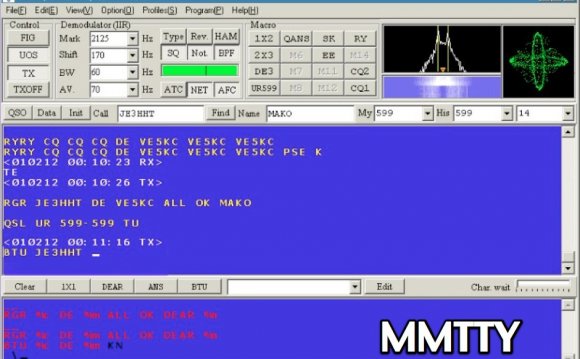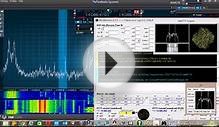
- An overview, summary or tutorial about the basics of RTTY or Radio Teletype, one of the first "digimodes" to be used and the RTTY frequencies used by radio amateurs.
Ham Radio Digimodes Tutorial Includes:
Digimodes summary AMTOR RTTY PSK31 Packet radio PACTOR
The first form of data transmission or digimode to gain widespread acceptance was known as radio teletype or RTTY. RTTY was widely used for commercial applications where it enabled printed messages to be sent quickly and without the need for a trained Morse operator. Once surplus equipment started to become available, radio amateurs started to use RTTY, and it soon became popular. In the early days of the use of RTTY, large mechanical teleprinters were used to print the data, but now with the ease of use of computers, these are used to decode and decipher the RTTY transmissions because they are quieter, smaller, more convenient and more efficient. However with the arrival of computers and their greater level of flexibility and sophistication, other more efficient types of digimode are available but despite this, the amateur RTTY is still widely used.
RTTY basics
RTTY uses a form of transmission known as frequency shift keying. The code representing the letters consists of a series of bits represented by high and low voltages. In turn these are represented on the radio signal by a shift between two frequencies, one frequency signifying a mark or high voltage and another frequency representing a space of a low voltage.
On the HF bands the carrier for the RTTY signal is shifted between two frequencies, and this gives rise to differing audio tones when a beat frequency oscillator or BFO is used. At VHF and above a frequency modulated signal is generally used for RTTY and this is modulated by an audio tone that changes.
The code for the data to be sent consists of five bits of either a mark or a space for each character. The actual code that is used is called the Murray code or Baudot code. This code is internationally recognised and to accommodate the various international requirements a number of national variations exist, although they are relatively minor.
Letter shift and figure shift codes are sent to change from upper case to lower case and vice versa. Once the code has been sent then the system will remain in that case until the next case-change code is sent. One of the drawbacks of RTTY is the limited set of characters that can be sent - only text and numbers, and very few other characters.
align="justify">When using RTTY, the data is sent relatively slowly because the mechanical teleprinters could not cope with data any faster and the standard has remained in place to retain compatibility with existing equipment despite improvements in current technology. 45.5 baud is the standard speed for amateur radio HF operation, although other standards at 50, 56.88, 74.2, and 75 baud exist. The RTTY frequency shift between the two tones used to be standardised on 170Hz but this is often increased to 200Hz as a result of the many of the new digital modes. As the difference between the two standards is relatively small there is no incompatibility between them. Typically the 170 Hz difference is generated using audio frequencies of 1445 Hz to represent a mark condition and 1275 Hz to give a space.One of the advantages of RTTY having a low data rate is that it means the bandwidth required for the transmission is relatively low. It is easy to gain a rough estimate of the bandwidth required by doubling the baud rate and adding the frequency shift. For example, a 50 baud transmission using a 200Hz frequency shift would require a bandwidth of 300Hz, so a 500Hz filter would be quite acceptable. By using a narrow filter, the effects of interference can be minimised.
INTERESTING VIDEO












